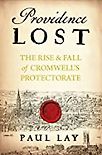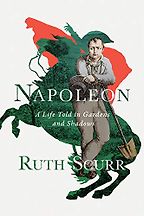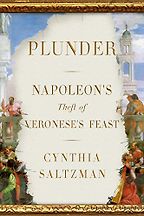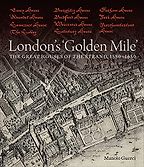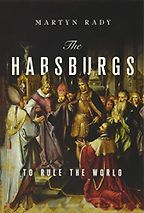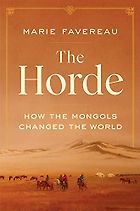Before we get to your selection of the best history books of 2021, I wondered if you have seen any trends in history publishing this year. It was the 200th anniversary of Napoleon’s death, which is reflected in your choices. Are we about to have a slew of pandemic history books coming down the track? Or are they already being published?
An awful lot has already been published of one kind or another on the pandemic. There are a lot of historical parallels being drawn, but I think it’s going to take a long while for us to really appreciate what happened. You have this febrile social media so prominent, making immediate judgments about things. At one moment the UK was doing catastrophically badly, and now the EU is having its moment. I don’t think any of us really appreciate exactly why there are spikes and why there are drops and why societies seem to be doing well one moment and not doing well another. These are important questions and there are obviously lessons to learn, but I think we’re still a long way off from really understanding what this is about. Vaccination is the key to everything.
Let’s turn to the books. So Napoleon died 200 years ago this year and you’ve got a couple of books on him, neither of which is a traditional biography. Tell me about the first one: Napoleon: A Life in Gardens and Shadows by Ruth Scurr.
When the anniversary of a great man like Napoleon comes around, I tend to think, what more can you tell me? Napoleon’s life has been extraordinarily well documented. It’s not a story we’re unfamiliar with. But if there’s one person who can bring new angles to this subject, then it would be Ruth Scurr. She is one of the most original, brilliant historians there is. She’s also a fantastic writer whose historical works are real works of literature.
So, when I saw that Ruth Scurr was writing a biography of Napoleon by focusing on his interest in gardening, I knew it was going to be fascinating. Ruth takes enormous risks. You always think it could be a catastrophe, that she won’t pull it off. Her last book was a life of John Aubrey, which was half related to historical sources, half imagined, with a real understanding of Aubrey and his times. It could have gone horribly wrong, but she pulled it off. It was a fantastic read.
She’s done exactly the same with this book which is, again, based on a very high-risk premise. It’s fascinating. At the core of it is the relationship between Napoleon and Josephine. Both have a tremendous interest in horticulture and gardens. They, of course, eventually have the means to create gardens on a formidable scale, but their philosophies are poles apart.
Josephine liked the jardin à l’anglaise, as they call it, which is a structured garden that looks wild, as though it’s unkempt. It’s a kind of shabby-chic garden philosophy, with broken paths, and no apparent structure to it—although of course there is. Napoleon, who remember is a great mathematician, a great strategist, a man who likes order, a man who’s used to commanding and getting his way, prefers the French style of gardening, which is imposed from above. It’s all about order, structure, and the projection of power. He marshals his gardens much as he marshals his troops, he’s in complete command, whereas Josephine prefers this improvised style, that’s much more chaotic. It says a great deal about their relationship, which ultimately fails.
“His vast empire has been reduced to these little plots on St Helena, miles from anywhere”
Scurr is very interesting about why Napoleon is so concerned with order. One of the key moments of his life was when he was a young soldier in the Revolutionary Army and he witnessed the massacre of the Swiss guard in the Tuileries gardens in Paris. He sees a revolution, of which he’s been a supporter, running out of control. This acted as a warning to Napoleon about what happens when control is lost, when authority loses control, and you see that philosophy in his gardens.
The book is also very moving. Napoleon took a great interest in horticulture as a child and, at the end, he almost becomes a child: you know, in his beginning was his end and in his end was his beginning. He’s there isolated on St Helena, thousands of miles from civilization. He constructs his plots of land, and it’s the one area in which he has control again. It gives meaning to those lonely, isolated days and Ruth Scurr, as she always does, tells this story brilliantly and movingly.
So gardening was Napoleon’s great comfort on St Helena?
Yes, I think it was. He was this lonely figure far away from anything that he’s known. It’s cold. He becomes ill eventually, with stomach cancer or some kind of digestive ailment that eventually kills him. That’s the sadness of it. His vast empire has been reduced to these little plots on St Helena, miles from anywhere. But he still manages to have some control over this one cultural pursuit that is still allowed to him, and which mirrors his childhood on Corsica. He had this Italian heritage. He was always an outsider, in a way. There was something about him that wasn’t quite French. He was always a one-off, and he sensed that and found comfort in plants as a child. And he finds that comfort again as this fallen hero, this huge figure who is suddenly in this diminished space. It’s very moving, very, very well told.
Excellent. It’s probably a slightly less sympathetic portrait of him in the next book you’ve chosen, Napoleon’s Plunder and Theft of Veronese’s Feast by Cynthia Saltzman. Tell us about this book.
One of the things that Napoleon aimed to do when he was in his pomp—and this was very much in line with his being a figure of the Enlightenment—was to make Paris the cultural centre of the world. As his empire expanded, he would take things from these newly acquired lands and bring them back to Paris as a treasure trove. It was plunder and one of the things he wanted above all was Veronese’s absolutely enormous, sumptuous masterpiece.
It hangs opposite the Mona Lisa in the Louvre, doesn’t it?
Yes, it does. It completely overshadows the Mona Lisa in terms of its artistic genius. It’s a riotously colourful biblical scene with an enormous cast of characters. It depicts The Wedding Feast at Cana, when Christ turns water into wine.
It’s also about Venice. Venice, a once great maritime empire, by this time is in precipitous fall. In Venice it had hung in San Giorgio Maggiore, which was a kind of diplomatic centre where the Republic of Venice greeted distinguished visitors. To be taken to France it had to be taken off the wall and cut in half. It was brutal in the way it was done, but Napoleon makes a kind of science of plunder.
Get the weekly Five Books newsletter
The old Louvre had been renamed the Musée Francaise in 1793. Then, in 1803, in an act of megalomania, it was renamed the Musée Napoléon. The plan was to bring the greatest things from Rome, Florence and Venice. In April 1797 a French ship—which ironically is called the ‘Libérateur d’Italie’—enters the Venetian lagoon and the captain is shot. In the following months, Napoleon declares war on Venice and this works out very nicely because his commission has identified 20 works of art in Venice to take back to Paris, 16 paintings and the four bronze horses which reign over the facade of St. Mark’s Basilica, which are supposed to be the work of the ancient Greek sculptor Lysippos. They themselves were looted from Constantinople by the Venetians during the Fourth Crusade in 1204.
We talked about how moving Ruth Scurr’s book is. This one is also very moving about the way this vast masterpiece is ripped from the wall of the refectory of San Giorgio Maggiore. It’s rolled up and packaged for this perilous, damp voyage to Paris. And yet, it survives. It’s still there now in the Louvre. It’s never been returned.
What Saltzman does is she tells the story incredibly well, so you get a really thrilling blend of historical narrative and art criticism. You get to understand a lot about Veronese’s technique and the use of these incredibly sumptuous, expensive colours that he was allowed to work with. What’s interesting about The Wedding Feast at Cana is it’s not the creation of a workshop. Veronese painted it all.
The book raises questions that are very pertinent and very modish at the moment about where works of art belong. Should it be returned to San Giorgio Maggiore? I don’t think France is going to give it back anytime soon. Saltzman argues that it’s a superior work to the Mona Lisa, with which it shares a room at the Louvre. The Mona Lisa is a remarkably simple painting, whereas Veronese’s is full of narratives and of scenes within scenes. It takes an awful lot to read and Saltzman shows us how to read it. It’s a thrilling story in all kinds of dimensions. And it’s beautifully done.
Let’s move on to The Horde by Marie Favereau, the next of your best history books of 2021.
Over the years, as editor of History Today, I’ve commissioned two or three pieces on Chinggis Khan and the Mongols. One always feels we’ve never quite got to the core because they’re so alien in a sense, so distant in time and in geography. You’ve got to take in everything from China, through Central Asia, to Russia, even to Eastern Europe. We’re talking about a grand geographical range, and a grand chronological range as well.
Favereau covers about 400 years of history and I felt that this is the book that’s come closest to allowing me—and therefore I think lots of others—to understand this unfamiliar world. It’s painted on a huge canvas. She uses the phrase ‘empire on horseback’. We tend to think of the Mongols—with some justification—as bloodthirsty, genocidal maniacs, going across the plains of Asia. This book suggests something a little more nuanced.
“It’s an incredibly compelling read and it changes the way you see the world”
Favereau is asking, ‘What is the state?’ We’re used to settled states with geographical limits, where monarchs or assemblies are sovereign. This is a different kind of state. But it is a state and it’s one that offers trading links on an enormous scale. At its best it also offers security for very, very different communities to interchange with one another—principally for the purposes of trade. Along the Silk Road, the geographical range is so vast and that’s reflected in incredible ethnic and cultural diversity.
There’s a fantastic use of sources here that shows you that difference. She uses Mongolian sources, which of course are absolutely crucial because you hear the voices of people within the Mongol world: administrators, people who fought and people who led. You also have a lot of Russian sources—the exchange between Russia and this empire is often under-appreciated. You also have a lot of Persian and Turkic sources. Islam is very important in this world as well. So there’s a lot going on, and there is undoubtedly a great deal of conflict. But there’s also a great deal of exchange, of toleration and, certainly, a tremendously dynamic economy. It’s an incredibly ambitious book with a huge range. It presents this world in its full complexity. It’s an incredibly compelling read and it changes the way you see the world.
Can you elaborate—why does it change the way you see the world?
Because you have a new definition of—or a new variety of—‘empire’ and ‘state’ that’s not really like anything you’ve seen before. Until I’d read this book, I didn’t really perceive the Mongols as anything but bringers of chaotic, marauding hordes, a bit like the Vikings. But they offer security and create a kind of state and a kind of empire, albeit one very different to those we are used to talking about in the West. It’s really illuminating in that and you begin to think again about what we might mean by ‘empire’, and what we might mean by ‘the state’.
Next up is London’s Golden Mile, by Manolo Guerci.
This is a book I only came across about a month ago. It’s a beautifully produced book by Yale University Press. They always produce rather sumptuous books. It’s also a piece of detective work, about the great buildings that were created on the Strand between roughly the 1550s through to the 1650s. The early part sees Henry VIII’s break with Rome and the English Reformation, when a new class of rising Protestant bureaucrats—the Cecils, the Howards, Thomas Cromwell—follow Henry VIII’s lead when he takes over Thomas Wolsey’s Whitehall Palace and makes it the centre of government.
The people around him, newly enriched by the dissolution of the monasteries and other transfers of the land, decide to make their physical presence felt in these houses—they call them ‘houses’, but they’re really palaces. There are eleven of them, and they link the government part of London, which is Whitehall, and Westminster, by means of this 100-meter ribbon to the legal and business world of the City.
These extraordinary houses owe something to European patterns, but are also English in their way. The great tragedy is that almost nothing of them remains. There’s an arch on the Victorian Embankment from one of the houses but they disappeared mainly during the civil wars.
The first of these houses was in the middle of the Strand and was Somerset House, built in 1547—not the Somerset House that stands there now. This was built on the orders of Edward Seymour who became Lord Protector, the brother of Jane Seymour, who’d married Henry VIII. This grand building became the blueprint for the other 10 houses. It’s ironic that Seymour was this great Protestant figure: the house ended up being the residence of four queens, three of whom were Catholic. Elizabeth I lived there before she became queen, but so did Anne of Denmark, Henrietta Maria and Catherine of Braganza.
Five Books interviews are expensive to produce. If you're enjoying this interview, please support us by donating a small amount.
This very grand building set the mark for all the others. Guerci tries to recreate them, using floorplans, descriptions, and particularly Wenceslaus Hollar’s fantastic drawings and illustrations of this period. Wenceslaus Hollar was a Czech/Bohemian illustrator who came over to London and was one of the great visual chroniclers of early modern London. We have his drawings and one particularly illuminating example is a bird’s eye view of Covent Garden and the Strand, which tells us a lot.
The book is brilliantly structured. Once we get through the introduction, we see each house going from east to west. Somerset House is the third of these. He includes the oldest of the Strand houses, the Savoy Palace. All of these palaces were originally bishops’ inns. Two of them stood on the north side of the Strand, the nine others were on the south side, often with very elaborate riverside terraces, with enormous gardens where one could enter from the Thames.
Bedford House, which was built by Edward Russell, the third Earl of Bedford, had this enormous garden at the back, which extended into Covent Garden, and the fourth Earl left a remarkable legacy of Palladian buildings. Palladio was, of course, the great inspiration for Inigo Jones, who was the first man to bring Palladian classicism to England, with the Covent Garden Piazza, and his St. Paul’s Church. Guerci stresses the difficulty of reconstructing these lost palaces. It’s incredibly difficult to do.
It was the Civil War and its aftermath which eventually led to the demolition of the Golden Mile. Now there is the Embankment, King’s College London, the Savoy Hotel and an endless number of chain shops that ends right about Charing Cross Station. All that is left are the names on the streets—Russell, Bedford, Henrietta.
Is the current Somerset House built round an original courtyard?
It’s not built on the plan. It’s just built on the site. The most astonishing thing of all is how little is left. There are almost no traces. In fact, I was walking up there, having read the book, and was trying to recreate something and it’s quite difficult to see any kind of legacy that’s been left there by these houses. They’re like butterflies that emerged and then disappeared. It’s quite extraordinary. And this book is something of a revelation because most of us don’t realise just what architectural wonders were there.
The break with Rome seems to me to be the real revolutionary moment in English history. That was when England becomes different. And these buildings were symbolic of a changing of the guard. The Catholic Church was out. Its bishops were out. This was a kind of secularisation in governance. They were very capable men, crucial to the way in which the English state was reimagined. These houses are symbolic of that.
The last of your best history books of 2021 is The Habsburgs by Martyn Rady. What story does this book tell about them?
Martyn Rady is a specialist in Eastern Europe: he is at the School of Slavonic Studies at the University of London. He’s written principally on 20th-century history, particularly with an interest in dictatorship, fascism and totalitarianism.
In this book, he tells us the story of the Spanish Habsburgs—Charles V and Phillip II in particular. What he does is restore the primacy of Central Europe to the Habsburg dynasty’s story. He takes us right back to the beginning, to a place called Habsburg and their very modest roots in Switzerland.
The Habsburgs always refer to themselves as ‘the house of Austria’. Rady argues that this concept of Austria was as much an idea as a geographical location or base. They had this acrostic, A.E.I.O.U., in both Latin and German: ‘Alles Erdreich ist Österreich untertan’ or ‘Austriae est imperare orbi universo.’ It could be translated as ‘Austria is to rule the world’. It was an ambition that, for a while, the family pretty much fulfilled. Charles V became not only Holy Roman Emperor, but also King of Spain. His son, Philip II, has this great moment at the Battle of Lepanto in 1571, where the Christian alliance he formed defeated the Ottomans near the Gulf of Corinth. That is the high point.
After that, you have some very strange characters. Perhaps the strangest is Rudolph II, a fascinating character who moves the Habsburg capital from Vienna to Prague for a brief time. Prague during this period becomes the European centre of alchemy and other magical arts. Rudolph has this ‘wonder chamber,’ as he calls it, and is seen as a Prospero-like figure. But all around him Protestantism is flourishing. There’s a revolt in Bohemia that would spark the 30 Years War. That ended with the Treaty of Westphalia in 1648, which is an important moment for the Habsburgs because that sees the emergence of, or the definition of, the nation-state, which by its very nature is a threat to Habsburg imperialism. In one sense, that is the beginning of the end, although there’s a long tail. With the Ottomans at the gates of Vienna in 1683, Emperor Leopold I manages to get forces to defend the city, and the Turks are repulsed. He’s acclaimed as the champion of Christendom, but in Spain it was all unravelling due to the succession crisis. Eventually, the Habsburgs lost Spain and all of its possessions in the New World and the Pacific following the War of the Spanish Succession.
They then faced two new threats as they retreated into central Europe, their original home. The first of these was intermarriage, which led to infertility and terrible ill health. By the 18th century, they were an incredibly unhealthy family. Secondly, you have the emergence of Frederick the Great’s Prussia. Then you have the dissolution of the Holy Roman Empire in 1806 by Napoleon. And yet, even then, the Habsburgs still play a role in the defeat of Napoleon because it is their agent Metternich, a man described as an elegant dandy, who organises the Congress of Vienna to help repair Europe following the Napoleonic Wars. He’s quite a formidable character and one of the heroes of this book. The peace that he constructs in 1814 holds for the best part of a century. It’s not until 1914 that a major war happens again, and Rady gives a lot of credit to Metternich for that. By contrast, he sees Emperor Franz Joseph as inept.
Franz Joseph’s last words on his deathbed were ‘why does it have to be now?’ The book’s full of these tremendous little things. He doesn’t just tell the main story. Rady is quite a mischievous writer. He’s full of little gems of knowledge and asides. For instance, that the Brazilian football team play to this day in Habsburg colours. And that Beethoven’s Seventh Symphony, which he conducted at the Congress of Vienna, was his atonement for dedicating the Eroica to Napoleon. In less capable hands, this could be a mess, because there are all kinds of threads coming together, but he manages to put those strands together in a lucid and elegant way. Too many books these days are too big. He tells this story with a great deal of economy and concision. It’s really difficult to imagine anyone writing a better history of the Habsburgs. It’s great fun. It’s the way history should be done.
Part of our best books of 2021 series.
Five Books aims to keep its book recommendations and interviews up to date. If you are the interviewee and would like to update your choice of books (or even just what you say about them) please email us at [email protected]

